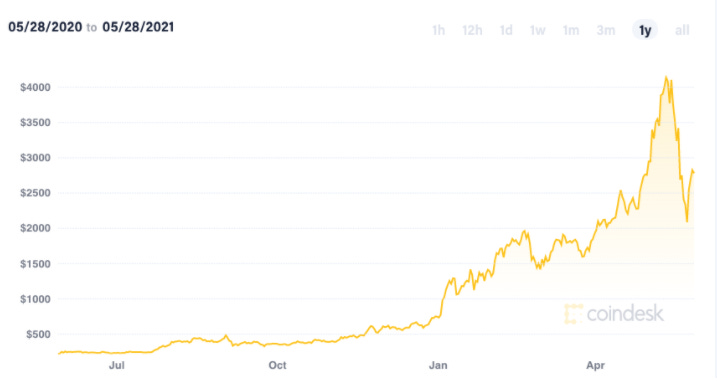Nothing in this post should be considered financial advice and I am not telling you to buy any specific cryptocurrency.
If you hate the idea of cryptocurrency, the last few weeks have probably been great for you. The price of Bitcoin, Ethereum, and joke currencies like Dogecoin have all tanked. You might feel like you have the right to laugh at your friends who fell for the hype and tell them that the whole concept of crypto is stupid and it’s all just a Ponzi scheme by Internet nerds.
Of course, it’s important to take a long-term view of the cryptocurrency space. Just last year, the price of Bitcoin was around $9000. Even with the recent price crash, it’s still worth around $35000. If you invested last May, you should be seeing 4x returns.
Back then, the price of Ethereum was just around $200. Now it’s worth around $2350. If you invested last May, you should be seeing 12x returns.
So if you hate the idea of cryptocurrency, please recognize the fact that you’ve been repeatedly wrong before and that this “price crash” really doesn’t prove your point. Because I’m a petty person, I’m writing this article to discuss why even if this crash in prices lasts several months, you people are going to be wrong again.
The price of Bitcoin is a leading indicator
The first time that I bought Bitcoin was back in May 2020. However, I’m embarrassed to admit that I didn’t really start getting into crypto until the end of last year when Bitcoin’s price started rising again. That made me do more research on Bitcoin and other cryptocurrencies like Ethereum and Chainlink.
I’m definitely not the only person who became obsessed with crypto in the past few months. It’s undeniable that the recent crypto boom has brought tons of new people into the ecosystem. As you can see the Bitcoin, Ethereum, and Cryptocurrency communities have all seen huge gains in subreddit members in the last few months, as the crypto market has become more and valuable.
Notice the last time that these subreddits saw an exponential increase in new users? It’s right around the end of 2017, which was the last time that Bitcoin saw a huge increase in price.
There’s a reason why this is important. Chris Dixon, who leads the venture capital firm Andreesen Horowitz’s cryptocurrency fund, has said that the price of Bitcoin is a leading indicator in the cryptocurrency world. A rise in the price of Bitcoin means that smart people get sucked into the crypto rabbit hole and start building cool projects. Of course, it usually takes a few years for these projects to be up and running and attracting new users.
Even though Bitcoin crashed in 2018, Andreesen Horowitz had faith that the crypto projects getting built would eventually revive the entire space. In 2019, the firm doubled down on their bet by buying more shares in a company in their portfolio, Coinbase. Meanwhile, other venture capitalists were desperate to get out of the investment because many of them believed the narrative that crypto was a fad and that its time had passed. As a result, Andreesen Horowitz was able to buy shares in the company for just $23 apiece.
Now, Coinbase is a publicly traded company, and its shares are worth $236 each.
In just two years, Andreesen Horowitz managed to make a more than 10x return on their investment. It all happened because while the media was saying that crypto was dead, the firm stuck to its thesis and recognized that it would take multiple years for cool projects to emerge from the 2018 price crash. They turned out to be right. Last year, we saw multiple projects in decentralized finance and NFTs finally came to fruition.
We will see this same dynamic play out again. This time, even more people fell into the crypto rabbit hole and many of them have already started to build new projects.
Why saying there’s a crypto bubble isn’t necessarily a bad thing...
Cryptocurrency might be a new technology with no precedent in human history. Still, it’s important to remember that we human beings are just as stupid as ever. Every time there’s a new technology — we get overexcited and end up screwing ourselves over. It happened with canals in the 1700s and railroads in the 1800s, and it’s happening with cryptocurrency today.
If we look at bubbles in new technologies throughout history, we can see a pattern.
Each time, there’s a huge bubble followed by a huge crash followed by slow and steady growth.
The bubble phase happens because people get excited by new technologies and start speculating. Eventually, the bubble pops and investors end up losing a ton of money.
We’ve definitely seen this play out in the cryptocurrency space. It’s been estimated that $12 billion worth of leveraged positions in Bitcoin got wiped out last week. People were essentially borrowing money to buy Bitcoin, and they were forced to sell just to limit their losses.
Of course, this bubble phase can serve an important purpose — infrastructure gets built that ends up enabling sustainable growth later on. For example, during the dot-com bubble, telecom companies raised $1.6 trillion dollars to lay more than 80 million miles of fiber optic cable in the United States. Even though many of those telecom companies ended up going bankrupt when the bubble popped, their work became very important later on. This investment gave millions of Americans access to fast, reliable Internet. That set the scene for companies like Facebook and Google to thrive a few years later.
Better infrastructure is coming…
Just like the dot-com bubble set the scene for the tech companies of today, better infrastructure is coming for cryptocurrency as well. Let’s take at two interesting subsections of the cryptocurrency space: decentralized finance and NFTs.
Better infrastructure for decentralized finance
I’ve written about decentralized finance in the past — these protocols give users the ability to take loans, earn interest, and make trades without having any traditional financial institution in the middle taking excessive fees from users.
The biggest problem with these DeFi protocols is that they’re hard for any normal person to use. Right now, they’re only being used by hardcore crypto nerds.
This might be changing in the near future. A couple of weeks ago, Coinbase announced a Chrome browser extension that will make it easier for Coinbase Wallet owners to connect to decentralized finance protocols. This is a big step towards making projects like Uniswap and Compound more accessible to normal people, especially when you consider that Coinbase has 56 million users.
Better infrastructure for NFTs…
Right now, NFTs have a big problem. There’s not really a place that you can show them off to your friends once you buy them. That means that for many people, it’s hard to justify an NFT purchase. It’s kind of ridiculous to pay $69 million for a piece of digital art if you don’t even have the opportunity to flex on your social media followers.
Of course, the NFT boom has led to the creation of new startups that can help to solve this problem. Companies like Gallery and Mark Cuban’s Lazy.com are building social media platforms that also serve as NFT galleries.
If just one or two of these companies are successful, they’ll provide sustainable infrastructure that will benefit the NFT ecosystem. If people have a way to show NFTs to their friends and family, they’ll be more likely to buy them. That means artists can more reliably use NFTs to supplement their existing income.
Why I’m still bullish on cryptocurrency
The crypto haters might be rejoicing right now and calling the whole space a fraud for dorks who worship Elon Musk. Still, it’s amazing to see how far crypto has come from the very beginning. Back in 2008, some unknown person who went by the name Satoshi Nakamoto emailed a small cryptography email list about a new digital currency he created called Bitcoin. It seemed pretty unlikely that the project would amount to anything useful or valuable.
Now, Bitcoin is worth $659 billion in total, while blockchains like Ethereum attract thousands of developers who are interested in building decentralized projects. Crypto has been on a wild ride in the past thirteen years — but it’s nothing compared to what’s coming next.
Anyway, if you liked this article, please sign up for our weekly newsletter. We send one article on business and tech every week, written for normal people and not Boomers who subscribe to Bloomberg.











